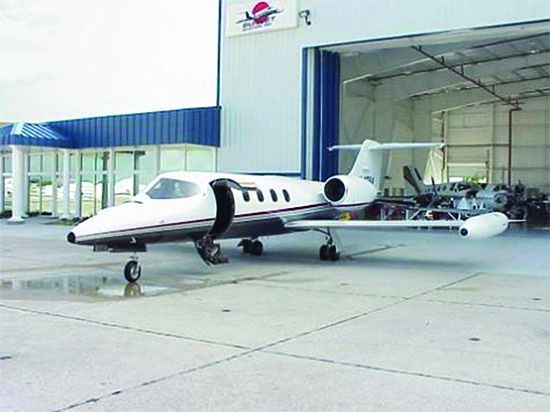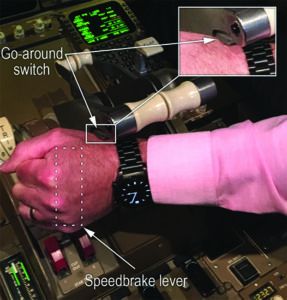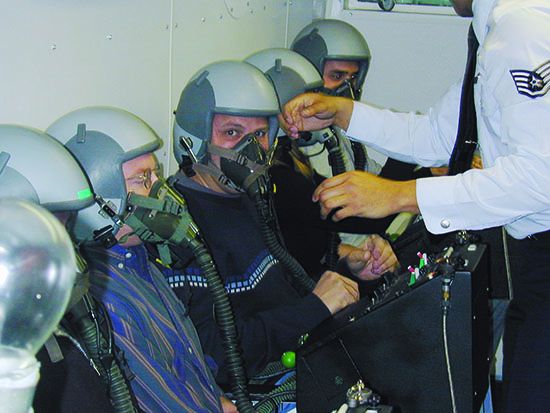There I was, a second lieutenant in the U.S. Air Force’s undergraduate pilot training (UPT). I look back now and think, “Was I really ever that young? Is anyone?” Everything was new and exciting about flying. The USAF really puts a lot of effort into training pilots, I found out. I thought when I joined up we would just start flying airplanes, like I did out at Hector Airport in Fargo (yes, like the movie). But no. There was a lot to do besides jumping into a cockpit and flying.
We had to go through a lot of what I thought was “non-flying” training. Like the altitude chamber, and hypoxia training. And spatial disorientation training. They put a bunch of us into the altitude chamber, sealed the door and sucked out the air. We watched the big barometer on the wall go up, up and up until we were at 25,000 feet msl. We all had helmets and oxygen masks on, and the flight surgeon, watching from outside the chamber, told us to drop our masks, and then when we felt “hypoxic,” we should put them back on. Part of the idea is to remember our symptoms, for the future.
HYPOXIA SYMPTOMS
So we sat there at 25,000 feet, and I was determined to be “tough” and hang in there, and not become hypoxic. After all, I was a marathon runner in the past, and ran every day. I always tried to run the 1.5-mile fitness test in 7:30, a five-minute-mile pace, so I thought, “I am not going to get hypoxic.”
One by one, the other students put on their masks as they felt the symptoms of hypoxia. The flight surgeon told us that some of the symptoms of hypoxia would be dizziness, loss of color in our vision or, of course, passing out.
Finally, I was the last student in the chamber without a mask on, all the rest were sitting there on the benches with their masks on. The flight surgeon spoke to me through the intercom. “Hello there, Lieutenant Johnson, how are you feeling?”
“Fine, sir,” I said, and I did. My fingernails weren’t blue, I could still see color, I wasn’t dizzy. I felt like a Sherpa on Mt. Everest—I was immune to hypoxia! My fitness made me Superman! The group sat and looked at each other, and me—the last maskless student pilot. The flight surgeon spoke to me again on the intercom from outside the chamber a few minutes later.
“Lieutenant Johnson, what is your home town?” I said “Fargo, North Dakota. Tee hee hee hee heee!” Whoa, I was giggling at that? I swept that oxygen mask on right now. Giggling for no reason was my hypoxia symptom, I noted.
DECOMPRESSION
Then we did another exercise: rapid decompression. The flight doc took the chamber up to 45,000 feet, and we students all sat there with our helmets and masks on, all of us staring at the altimeter with wide eyes, in part because there’s simply not enough oxygen at FL450.
Then the flight surgeon in the chamber with us asked for a volunteer for an exercise. The exercise would be to take wooden shapes, like triangles, circles, stars and squares, and transfer them from one wooden board to another as quickly as they could, where there were empty, shaped holes for them. The student would do this with their mask on, he said, and then drop their mask when told to, while doing the exercise.
One of the students in my class was a woman who was an Olympic-level athlete. Very competitive, she eagerly volunteered. And the exercise started—she very quickly transferred the shapes from one board with holes to the other board with holes, racing. Then the flight surgeon said, “Okay, Lieutenant, drop your mask.” She did, and her head quickly dropped to her chest and bobbed around while she continued moving her hands left and right. But she wasn’t grabbing the shapes anymore; her arms were just moving left and right—kind of flopping and flailing, really.
The flight surgeon took her hat out of her lower left flight suit pocket as she flailed and put it in her right pocket. Then he removed her Velcro name tag. Then he reached over and clipped her mask back on. Her head came up and she sat up straight and continued putting the shapes from one board to the other. The flight surgeon said, “Hey there, Lieutenant, it looks like you’re out of uniform.” She said, “No I’m not, sir,” and then the flight surgeon said, “Oh yeah? Where is your name tag? Where is your flight cap?”
She looked mystified, searching. She had no idea she had been unconscious. That was an eye-opener for the rest of us. A person can go unconscious, black out almost immediately from rapid decompression, “come back to life” and not know it happened. Way creepy.

On October 25, 1999, a Learjet 35 crashed in Aberdeen, S.D., after its crew became unresponsive. Obviously on autopilot, it failed to follow its flight-planned route and headed off to the northwest on its own, reaching a maximum altitude of 48,900 feet msl (FL489). Hours later, after numerous military aircraft intercepted it and flew alongside, trying to get a response from the occupants, it apparently ran out of fuel and struck the ground at high speed. Popular pro golfer Payne Stewart, three other passengers and both crewmembers were killed. The NTSB determined the accident’s probable cause was “incapacitation of the flight crewmembers as a result of their failure to receive supplemental oxygen following a loss of cabin pressurization, for undetermined reasons. In other words, hypoxia. The NTSB noted that, “A possible explanation for the failure of the pilots to receive emergency oxygen is that their ability to think and act decisively was impaired because of hypoxia before they could don their oxygen masks.” The board went on to say that in investigations of other accidents where flight crews, who tried to diagnose a pressurization problem instead of immediately donning oxygen masks, have rapidly lost cognitive or motor abilities shortly thereafter, even if the loss of pressurization is gradual.
SPATIAL D
We students also learned quite a bit about spatial disorientation, “spatial D,” for short. How the eyes, if you stare at one light in the black sky at night, will appear to move. Learning about this one was embarrassing for me, Mr. Competitive.
The instructor had us look at a board attached to the wall above and behind him. On the board were three small red lights in a row. The instructor told us to stare at the middle light, and tell us what we saw. Then he turned off the classroom lights.
I focused and focused. Suddenly, the middle light began to move. I called out what I saw. “It’s moving left, sir. Now it’s moving right! Now it’s—it’s moving in a circle!” I was in a class with 25 other students, all but four of us were USAF Academy graduates, all super-competitive, too. I was “winning,” I knew it.
The instructor turned the classroom lights back on. The lights were fixed to the board, right where they were before he turned out the lights. Autokinesis is what that was. It involves rods and cones in your eyeballs, and a sheepish look on your facial features, at least in my case.
One really interesting spatial D exercise in the T-38 was the somatogravic illusion demo. The instructor pilot, in the back seat, would slow the aircraft way down to about 200 knots or less. Then the student (me), is told to close his eyes—don’t cheat. The instructor slams the throttles to full afterburner, and accelerates, straight-and-level, to about 450 knots. Then the IP says, “Open your eyes!” It felt like I was pointed maybe 40 degrees nose-high, but that big attitude indicator said nope, you’re level, smart guy.

I suspect the first officer aboard Atlas Air Flight 3591, a Boeing 767-300 that abruptly nose-dived into a shallow, marshy bay area near Houston, Texas, on February 23, 2019, never got training on somatogravic illusions. However it happened—one speculation is that his watch inadvertently triggered the airplane’s takeoff/go-around mode as he reached for the speedbrake handle to descend—he likely felt the aircraft accelerate and pitch up a bit. But it apparently felt like the aircraft was pitched way up, and he pushed and pushed on the yoke, putting the aircraft 50 degrees nose-low at 400 knots. Even though—of course—the attitude indicator read correctly. According to the NTSB, 32 seconds elapsed between the go-around mode activation and the airplane’s ground impact.
COLD
My KC-135 crew and I are in Fairbanks, Alaska, in the dead of winter. I’m the copilot. We went to Eielson Air Base on a December 12th for a four-week deployment (that turned into six) to refuel the spy planes that look at Russia, the Cold War enemy.
I thought I had experienced cold. Being from Fargo, N.D., I had seen 40 below zero, and remembered that’s where Celsius and Fahrenheit are the same. So I thought I knew cold.
Our navigator showed up one morning with his blue flight cap on and his black flight boots, instead of Arctic gear, which includes green insulated boots, a black wool stocking cap and big mitts. He wanted to “look sharp,” and he did. So, being an idiot, for the next flight I showed up at about 0400 with my shiny black leather flight boots on, and my blue flight cap.
As we taxied out in the cold darkness, a vehicle followed us, like they always did, looking for any “runs, drips or errors.” They spotted a drip on a brake, I believe it was. Out came the hydraulic repair team, and we had to shut down the engines. When we shut down the engines and opened the big door beneath the cockpit, minus 54-degree F air rushed into the airplane. After maybe 10 minutes, my feet turned to solid ice inside my shiny black leather flight boots.
I was panicking, begging for help. Finally the ground guys jammed a huge hot air hose up into the cockpit. I pulled my boots off and stuck my bare feet right into that hose. I think a few more minutes and I would’ve had frostbite. The lesson? When I got that cold, I was useless as a flight crew member. I was baggage.
Sidenote: There was a KC-135 crash out of Eielson AFB in the 1970s that all of us tanker pilots knew about—the crew was waiting in their aircraft for two hours at minus 50 degrees F with no heat before takeoff. No APU, no nothing. Then their gear wouldn’t come up after takeoff, and they focused on that and crashed: CFIT. But it was the bitter cold that got ‘em—froze them, gave them hypothermia, caused poor judgment.
FATIGUE
Another thing we really didn’t learn about in UPT was fatigue. All the training flights in UPT were about 1.2 hours or so, not enough time to get tired during flight. Up, down. Sure, maybe you’d fly three times in one day (“trip turn”) or twice (“double-bang”), but nothing like a five-or six-hour or nine-hour flight.
One time, in Alaska, we had a long flight (at night, of course). Then we had to divert from Eielson Air Base, where we took off, due to ice fog making the base zero-zero. A volcano, Mt. Redoubt, had recently erupted while we were airborne during another flight, and we almost had to divert. A KLM 747 flamed out all four engines, losing 14,000 feet. All we could hear was part of the conversation, because we had UHF radios and the airliner was on VHF, but we heard the words “crazed windshield,” and I and my aircraft commander looked at each other across the cockpit. “Whoa. Alaska!” we thought.
So we diverted that night, due to the ice fog at Eielson AB, to Elmendorf Air Base, near Anchorage, Alaska. While Eielson was 54 below zero, Elmendorf was sporting 30-something degrees above zero and rain. It’s on the coast, so the ocean keeps it warm.
So we did a descent into Elmendorf and on a long, extended final, my aircraft commander looked at me and said, “Your landing.” I was tired, but didn’t really realize it. I took over the controls, hand-flying the Boeing down final, gear down, flaps down, all looking good.
Until I realized we were flying down final pointed at the runway in a big crab. There was a pretty healthy crosswind, and suddenly I realized I was tired. My mind was sluggish. I thought, “Oh, right, this is normal—fly it straight to the runway in a crab, then wing-low, opposite rudder, flare, land.”
And I did, applying right rudder with the left wing low, landed and—oh, my. I made the rookie mistake of leveling the yoke once we were on the ground. You know, like driving a car.
Screaming along the runway at night in the rain on landing rollout, with that yoke suddenly leveled instead of into the wind, the huge grey left wing started to rise in the dark, and we veered off that centerline to the right quick as a scalded cat.
I panicked, and slammed the yoke full left, at the same time the aircraft commander yelled, “I have the aircraft!” and also yanked the yoke full left. I was frozen to the yoke, and slowly released it, even though I knew I should have let go immediately when he yelled. Being tired—fatigued—and not being ready for a night crosswind landing in the rain almost killed me. Us.
My aircraft commander slowed down the tank, and as we turned off the runway, said over the intercom, “Well, where do you guys want to go eat, since the copilot didn’t kill us, Mexican or Chinese?” And that was that, as far as a debrief went. Much like Ernest K. Gann wrote in Fate Is The Hunter, when he screwed up an early flight (raised the gear too soon after takeoff) and his captain said, “If you do that again, I’m taking you out of my will,” my seasoned aircraft commander, though younger than me, seemed old and wise, and understood that hammering me wouldn’t help.
REVISITING HYPOXIA
Hypoxia recently came back to visit me—no giggling this time. I’m flying along solo, “fat dumb and happy” at 13,500 feet in an unpressurized cockpit, without supplemental oxygen. I stayed there a little too long, even though I was timing it. I occasionally saw what looked like gnats flying around from time to time, out of the sides of my eyes. Little black dots that weren’t there. I felt tired, too, and thought, “I gotta get more sleep before I fly next time.” I landed safely, after descending to 9500 for a while.
Then just yesterday, I went in for an eye exam, and told the eye doc what I had seen. She said something like, “Oh yeah; that’s the oxygen leaving the body.”
Fatigue, hypoxia, cold weather—all are silent, deadly, insidious. They creep up on a pilot, little by little. No big fanfare, not much warning—just quiet killers. Symptoms are subtle, like drowsiness. Maybe giggling at nothing. Or gnats flying around the cockpit. Or sluggish thinking.
To ward off hypoxia, I have a cabin altimeter and a watch, pretty basic items; the idea is to time it so I don’t spend too long above 10,000 feet without oxygen. I do have an oxygen tank. Helps if I bring it along—hard to use if I leave it in the hangar. Warding off fatigue is a bit different—this involves coffee or Monster energy drink.
Matt Johnson is former U.S. Air Force T-38 instructor pilot and KC-135Q copilot. He’s now a Virginia-based flight instructor.




